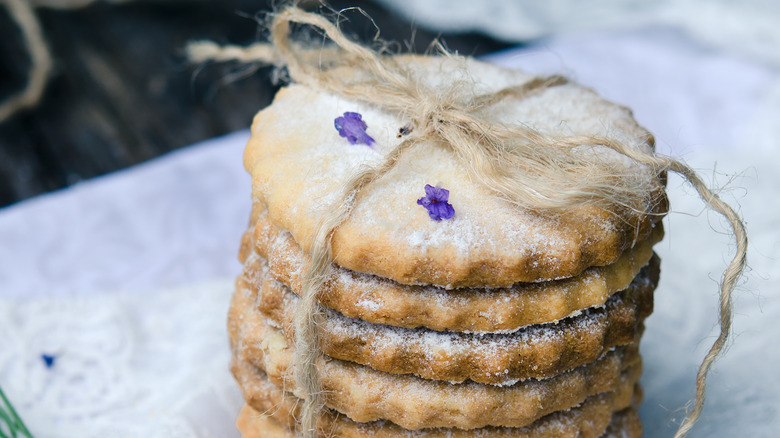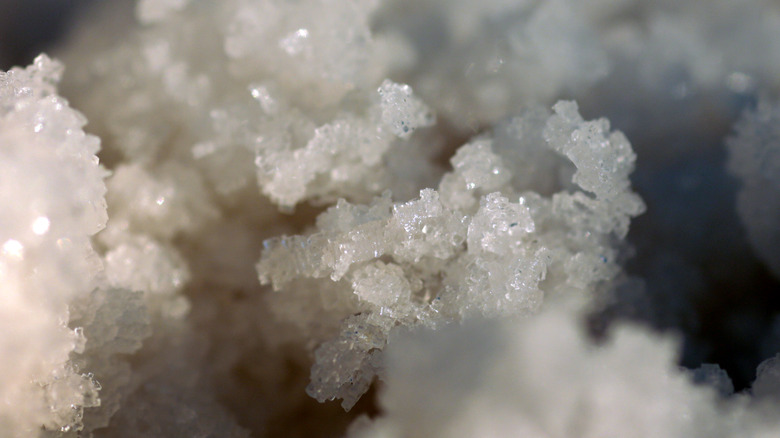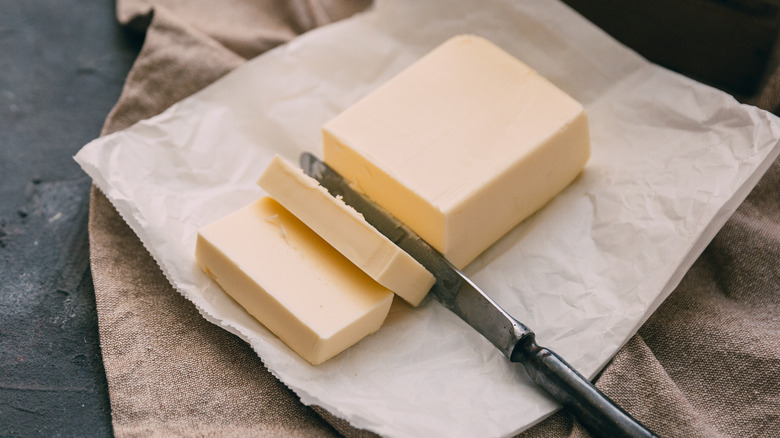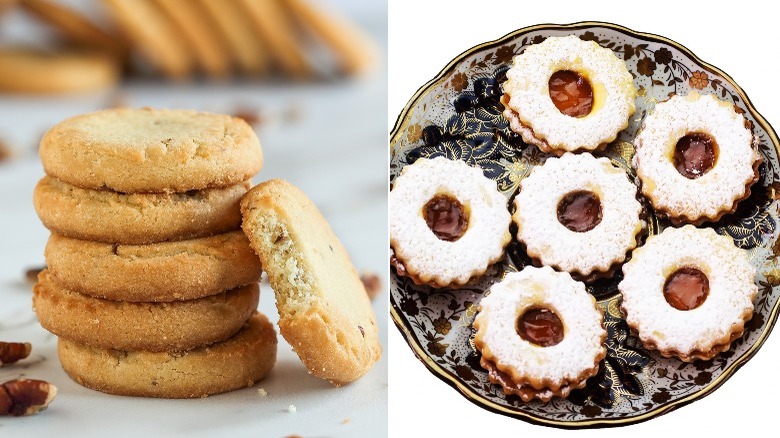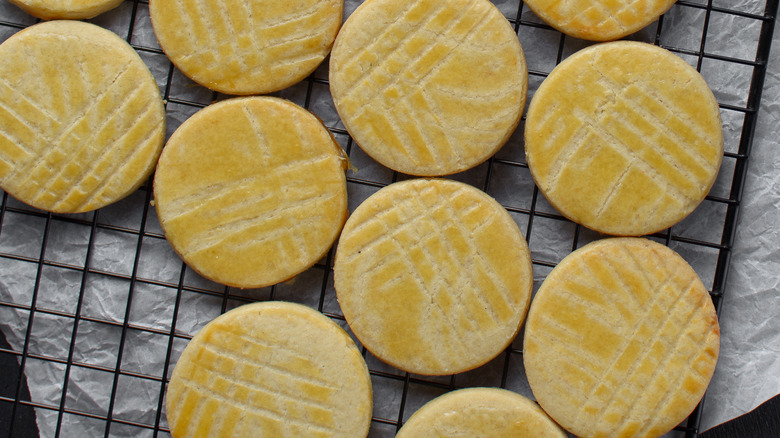What Makes French Sablés Cookies Unique?
We may receive a commission on purchases made from links.
The French have no shortage of iconic foods. We all recognize the savory goodness of boeuf bourguignon and the sublime sweetness of macarons. But there is another cookie that is so French that Taste Atlas names it No. 3 on its list of the most popular French cookies: sablés. Sablés, translated to English as "sand," are the decidedly French version of a shortbread cookie. Born in Pays de la Loire and perfected in Brittany, sablés are a delectable combination of the best ingredients the northwestern coast of France has to offer. We'll examine two elements, salt and butter, which play an extremely critical role in these cookies' unique texture and flavor.
As with anything French, there are right ways of doing things, wrong ways of doing things, and ways of doing things in between. Sablés cookies are no exception. You can go with the classic salty-sweet and flaky. Taste Atlas also says you can flavor sweet sablés with "lemon or orange zest, almonds" or go for savory with "green peppers, or cheese." Whatever variety of this cookie you make for your next get-together, you will be recreating a treat that was first created for the French Court of the 17th century.
From the court of Louis XIV
Long before they were the treat of the everyman, sablés were reserved for the royalty. Invented during the 17th century under the reign of King Louis XIV, the sablé became widely popular throughout the court (per Cooking with Frenchy). The King's brother, Prince Condé, was extremely fond of these little biscuits. According to Taste Atlas, in 1670, in the town of Sablé-sur-Sarthe, the steward of Prince Condé baked some shortbread cookies for the party the prince was attending. Also present at this party was the renowned philosopher Madeleine de Souvre, Marquise de Sablé. It is reported that this intrepid steward named the cookies in honor of the Marquise.
The town of Sablé-sur-Sarthe sits on the west edge of the region of Pays de la Loire (per Brittanica). The western portion of Pays de la Loire borders the region of Brittany, which is likely how the sablés became popular fare in the area. As we'll see, products of the Breton coast have gone a long way towards making sablés truly special.
Le sel
Much of the economies and cuisines of Brittany and Pays de la Loire regions are connected to the sea (per Explore France). Sablés are no exception. While the connection between the sea and these crumbly cookies may seem far-fetched, the first essential ingredient is salt.
The people of the town of Guérande on the Breton coast have been harvesting salt from the sea since Roman times (per Brittany Tourism). This ancestral skill has been passed down through the generations, where the salt farmers still rake the 10,000 metric tons of salt they produce each year by hand. The salt that comes from Guérande is known for its flavor and high magnesium content. It has been prized for its taste and preservative abilities for thousands of years. This special salt also serves as a chief ingredient and flavoring for the next crucial sablés component: butter.
Le beurre
Not all butter is created equal. There is a massive difference in terms of overall consistency and product quality between kinds of butter, and in order to make sablés properly, you need butter that has a high percentage of fat. Brittany Tourism explains that the special Breton butter is salted not only for preservation purposes but to enhance the flavors of the local Breton milk. These two elements are critical to achieving the flaky texture characteristic of sablés. To that end, The Good Life France explains that you need butter with a minimum of 82% fat content. Butters with lower fat content may contain too much water, which will create steam during baking and affect the final texture.
While the need for a specialty ingredient like Breton butter may deter some cooks, David Lebovitz writes that while specialty ingredients are not strictly necessary, they do tend to go a long way towards making a difference. In the case of sablés, the high-fat, top-quality butter is what gives the cookies their iconic flaky texture and salty-sweet flavor. And while you may not be getting your butter directly from Brittany, Lebovitz suggests brands like Échere, Kerrygold, Vermont Creamery, and Land-O-Lakes as readily available alternatives.
Sablés Variations
At one time in her history, France's colonial empire stretched across the world, with outposts in North America, Africa, and Asia (via The Latin Library). Some of the traditions of France were brought along to these colonies. One such colony was the now independent North African country of Algeria, where they have their own version of sablés. According to Food.com, Algerian sablés share the same basic formula as their French counterparts, but the main difference is in the construction. Algerian sablés are sandwich cookies with two outer biscuits and a jam filling. The center of the top biscuit is cut out to make the jam visible. Popular jam types include strawberry and apricot.
Another type of sablés is the palet Breton, a variety specific to Brittany. According to Brittany Tourism, these cookies are thicker, sometimes more than a centimeter. They were invented in 1920 by Alexis Le Villain. The name "palet" takes its inspiration from a local Breton game that involved throwing iron discs, or "palets," onto a wooden plank. Cooking with Frenchy tells us these biscuits are still a go-to game-time snack.
How to Make Sablés Cookies
The process of making sablés is relatively simple, but there are certain steps you need to follow precisely to achieve the best results. As listed by A Baking Journey, the ingredients are simple: salted butter, egg yolk, baking powder, flour, and icing sugar. It is also common to add flavors like vanilla or citrus zest. Both the egg yolks and butter must be at room temperature. That ensures that no unnecessary moisture is added to the mixture, affecting the flaky outcome you are looking for.
Once these ingredients are mixed together, they will appear like fine crumbles, which is where the whole "sand" part of the name comes in. This is packed into a dough ball and rolled out between two sheets of parchment paper until they are about a ¼ inch thick. Chill the dough for an hour, then cut out your biscuits, add an optional decorative pattern, and bake at 350 degrees Fahrenheit for 15 to 18 minutes until golden. Any leftover dough can be reformed and used to make more sablés. Allow your baked sablés to cool completely, and serve with a sweet coffee or a small glass of wine for savory varieties.
